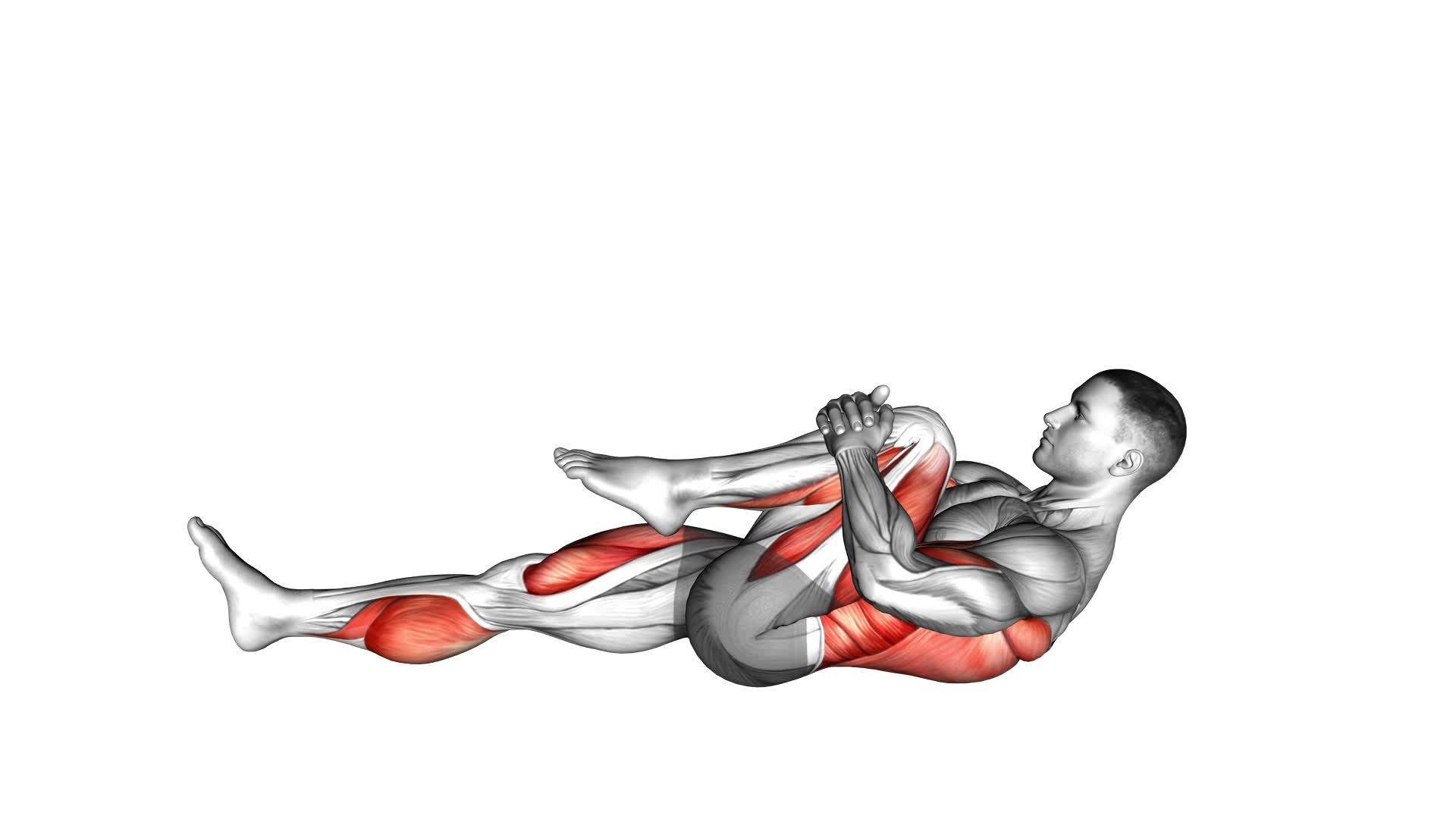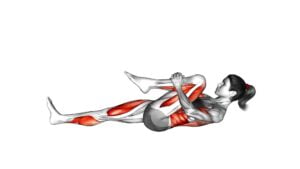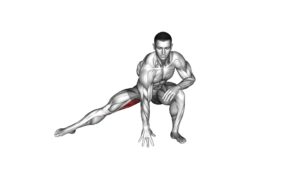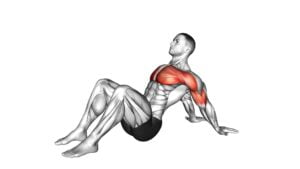Single Leg Stretch (Bent Knee) (Male) – Video Exercise Guide & Tips

Get ready to level up your workout routine with the Single Leg Stretch (Bent Knee) exercise! This video exercise guide and tips are designed specifically for men looking to strengthen their core and improve flexibility.
Watch This Exercise Video
You'll learn the proper form and technique, as well as precautions and modifications to ensure a safe and effective workout. Say goodbye to common mistakes and hello to variations and progressions that will challenge your muscles.
Ready to take your fitness to the next level? Let's get started!
Key Takeaways
- Single Leg Stretch (Bent Knee) targets the core, hips, and thighs, strengthening and toning these areas.
- Proper form and technique are crucial to maintain knee alignment, engage the core, and prevent strain on the lower back.
- Modifications and variations can be made to accommodate different fitness levels and reduce strain on specific areas.
- Incorporating Single Leg Stretch (Bent Knee) into a workout routine can improve balance, stability, flexibility, and overall effectiveness of the workout.
Benefits of Single Leg Stretch (Bent Knee) for Men
You can gain numerous benefits from incorporating the single leg stretch (bent knee) into your workout routine. This exercise specifically targets the muscles in your core, hips, and thighs, making it an excellent choice for men looking to strengthen and tone these areas. By engaging your abdominal muscles to stabilize your pelvis, the single leg stretch helps to improve your overall balance and stability. Additionally, this exercise can also improve your flexibility, particularly in your hamstrings and hip flexors.
To perform the single leg stretch (bent knee) with proper form and technique, start by lying on your back with your knees bent and feet flat on the floor. Slowly lift one leg off the ground, keeping your knee bent at a 90-degree angle. While maintaining a strong core, gently pull your knee towards your chest using your hands, feeling a stretch in your hip and thigh. Hold this position for a few seconds before returning your leg to the starting position. Repeat the exercise on the other leg.
Incorporating the single leg stretch (bent knee) into your workout routine can lead to improved core strength, increased hip and thigh muscle tone, enhanced balance and stability, and greater flexibility in the hips and hamstrings.
Proper Form and Technique for Single Leg Stretch (Bent Knee)
To perform the Single Leg Stretch (Bent Knee) exercise with proper form and technique, it's important to focus on three key points.
First, make sure to maintain proper knee alignment throughout the movement to prevent any strain or injury.
Second, engage your core muscles throughout the exercise to stabilize your body and maximize the benefits.
Lastly, pay attention to your breathing technique, inhaling deeply as you extend your leg and exhaling fully as you bring it back in.
Knee Alignment During Exercise
Proper alignment of the knee is crucial during the Single Leg Stretch (Bent Knee) exercise to ensure effective form and technique. Here are four key points to consider for proper knee alignment and prevention of knee pain:
- Keep your knee in line with your ankle: Align your knee directly over your ankle to maintain stability and avoid unnecessary stress on the joint.
- Avoid inward or outward rotation: Your knee should stay in a neutral position, with no excessive inward or outward rotation. This helps to maintain proper tracking of the patella and prevent strain on the ligaments.
- Engage your quadriceps: Activating your quadriceps muscles helps to stabilize the knee joint and support proper alignment.
- Mindful movement: Be mindful of your knee alignment throughout the exercise, making necessary adjustments to ensure proper form and prevent any discomfort or pain.
By focusing on these key points, you can maintain proper knee alignment, prevent knee pain, and maximize the effectiveness of the Single Leg Stretch (Bent Knee) exercise.
Now, let's move on to the next section about engaging your core muscles.
Engaging Core Muscles
Engage your core muscles for proper form and technique during the Single Leg Stretch (Bent Knee) exercise. By engaging your core muscles, you won't only maintain stability but also strengthen your lower back.
To engage your core, start by lying on your back with your knees bent and feet on the floor. Place your hands behind your head, elbows wide. As you exhale, lift your head and shoulders off the mat, engaging your abdominal muscles. Maintain this engagement throughout the exercise.
As you extend one leg out, keep your core muscles engaged to support your lower back. Alternate legs while keeping your core activated to maximize the benefits of this exercise and prevent any strain on your lower back.
Breathing Technique Importance
Maintain proper form and technique for the Single Leg Stretch (Bent Knee) exercise by focusing on your breathing. Breathing techniques play a crucial role in this exercise as they help you engage your core muscles effectively and maintain proper body alignment.
Here are four important reasons why you should pay attention to your breathing during the Single Leg Stretch (Bent Knee):
- Oxygenation: Deep breathing ensures an adequate supply of oxygen to your muscles, enhancing their performance and preventing fatigue.
- Core Activation: Coordinating your breath with the movement helps activate your deep core muscles, providing stability and control.
- Mind-Body Connection: Focusing on your breath helps you stay present in the exercise and maintain mindfulness throughout.
- Relaxation: Proper breathing technique promotes relaxation and reduces tension in your body, allowing for a more effective workout.
By incorporating these breathing techniques, you can optimize your Single Leg Stretch (Bent Knee) exercise and achieve better results.
Now, let's explore precautions and modifications for this exercise to ensure safety and effectiveness.
Precautions and Modifications for Single Leg Stretch (Bent Knee)
To ensure safety and effectiveness during the Single Leg Stretch (Bent Knee) exercise, it's important to make modifications and take precautions.
First and foremost, if you have any pre-existing knee or hip injuries, it's crucial to consult with a healthcare professional before attempting this exercise. They can provide personalized modifications to accommodate your specific needs and prevent further injury.
When performing the Single Leg Stretch (Bent Knee), it's recommended to start with a bent knee position rather than straightening your leg completely. This modification helps to reduce strain on the knee joint and minimizes the risk of injury. Additionally, if you experience any discomfort in your lower back, you can place a small towel or cushion under your tailbone for support.
Proper form and technique are essential for a safe and effective workout. Remember to engage your core muscles throughout the exercise and maintain a neutral spine position. Avoid excessive twisting or jerking movements, as this can put unnecessary stress on your spine and lead to injury.
Lastly, listen to your body and only go as far as you feel comfortable. If at any point you experience pain or discomfort, stop the exercise and consult with a healthcare professional.
Common Mistakes to Avoid During Single Leg Stretch (Bent Knee)
One common mistake to avoid during the Single Leg Stretch (Bent Knee) exercise isn't properly engaging your core muscles. Proper form is essential to maximize the benefits of this exercise and prevent injury. Here are some common mistakes to avoid:
- Lack of core engagement: Failing to engage your core muscles during the Single Leg Stretch can put unnecessary strain on your lower back. Make sure to actively pull your belly button towards your spine and maintain a strong core throughout the movement.
- Rushing the exercise: It's important to perform the Single Leg Stretch in a controlled manner. Avoid rushing through the repetitions and focus on maintaining proper form throughout the entire exercise.
- Using momentum: Swinging your legs or using momentum to complete the movement can diminish the effectiveness of the exercise. Instead, focus on using the strength of your core to control the movement and bring your knee towards your chest.
- Incorrect leg position: Ensure that your leg is properly positioned during the Single Leg Stretch. Your knee should be bent at a 90-degree angle and aligned with your hip joint. Avoid letting your knee drift inward or outward.
Variations and Progressions for Single Leg Stretch (Bent Knee)
Now let's explore some advanced modifications for the Single Leg Stretch exercise. These variations will challenge your core and increase the intensity of the workout.
Additionally, we'll discuss the benefits of the bent knee variation, which targets different muscles and allows for greater flexibility in the hips and lower back.
Advanced Modifications for Single Leg Stretch
For advanced modifications of the Single Leg Stretch (Bent Knee), try incorporating variations and progressions to challenge your workout. Here are four ways to engage your core muscles even further:
- Extended Leg Variation: Instead of keeping the knee bent, fully extend the leg straight out. This increases the demand on your core to stabilize your body.
- Double Leg Stretch: Begin with both legs bent and drawn towards your chest. As you extend one leg out, reach both arms overhead. Alternate legs, keeping your core engaged throughout.
- Scissor Variation: Start with both legs extended straight up towards the ceiling. Lower one leg towards the ground while the other leg stays lifted. Alternate legs, focusing on maintaining a strong core.
- Resistance Band Challenge: Secure a resistance band around your feet and hold the ends with your hands. As you perform the Single Leg Stretch, the resistance from the band adds an extra challenge for your core muscles.
Incorporating these advanced modifications will take your Single Leg Stretch to the next level and help you achieve a stronger core.
Benefits of Bent Knee Variation
To maximize the benefits of the Single Leg Stretch (Bent Knee) exercise, incorporating variations and progressions can further engage your core muscles. By modifying the exercise, you can target specific areas and increase the intensity of your workout.
One of the main benefits of the bent knee variation is that it reduces strain on your lower back, making it a suitable option for individuals with back issues. Additionally, this modification allows for better control and stability, promoting proper form and alignment.
The bent knee variation also provides a greater challenge for your abdominal muscles, as it requires more effort to stabilize your core while extending and flexing your legs.
Tips for Incorporating Single Leg Stretch (Bent Knee) Into Your Workout Routine
To effectively incorporate single leg stretch (bent knee) into your workout routine, start by positioning yourself in a comfortable and stable position. This exercise targets your abdominal muscles, hip flexors, and thighs, providing a challenging workout for your core. Here are some tips to help you make the most of this exercise:
- Engage your core: Before you begin, engage your abdominal muscles by drawing your belly button towards your spine. This will help stabilize your torso throughout the movement.
- Maintain proper form: Keep your back flat on the mat and your shoulders relaxed. Avoid arching your lower back or straining your neck.
- Use modifications if needed: If you find it difficult to keep your legs straight, you can modify the exercise by bending your knees slightly. This will reduce the strain on your hip flexors and allow you to focus on engaging your core.
- Breathe properly: Remember to inhale deeply through your nose as you extend your leg, and exhale fully through your mouth as you bring it back in. This will help you maintain control and stability during the exercise.
Incorporating single leg stretch (bent knee) into your workout routine can enhance your core strength and stability. By following these tips and practicing proper form, you can maximize the benefits of this exercise and achieve your fitness goals.
Frequently Asked Questions
How Many Sets and Reps Should I Do for Single Leg Stretch (Bent Knee)?
To determine how many sets and reps you should do for single leg stretch (bent knee), it's important to consider your fitness level. Beginners can start with 2-3 sets of 10-12 reps, while more advanced individuals can aim for 3-4 sets of 12-15 reps.
Remember to modify the exercise to suit your fitness level and engage your core properly. This will ensure you get the most out of the single leg stretch (bent knee) exercise.
Can I Perform Single Leg Stretch (Bent Knee) if I Have Knee Pain or Injury?
If you have knee pain or injury, it's important to be cautious when performing single leg stretch (bent knee). You may need to modify the exercise by reducing the range of motion or using a support, like a pillow, under your knee.
Alternatively, you can try other exercises that put less strain on the knee, such as seated knee extensions or standing leg curls.
It's always best to consult with a healthcare professional for personalized guidance.
Is Single Leg Stretch (Bent Knee) Suitable for Beginners or Should It Be Reserved for Advanced Practitioners?
Single Leg Stretch (Bent Knee) can be suitable for beginners as well as advanced practitioners. Beginners can modify the exercise by taking it slow and focusing on proper form. This exercise helps improve core strength, flexibility, and balance.
Advanced practitioners can benefit from the increased challenge by adding resistance or increasing the tempo. It's important to listen to your body and consult with a professional if you have any concerns or injuries.
Can Single Leg Stretch (Bent Knee) Help With Improving Flexibility?
Improving flexibility is a common goal for many people. Single leg stretch (bent knee) is an exercise that can help you achieve this. By engaging your core and stretching your legs, this exercise can target the muscles that contribute to flexibility.
In addition to flexibility, single leg stretch also offers other benefits like strengthening the abdominal muscles.
If this exercise doesn't suit you, there are alternative exercises that can also help improve flexibility.
Are There Any Specific Breathing Techniques to Follow During Single Leg Stretch (Bent Knee)?
During single leg stretch (bent knee), it's crucial to focus on your breathing. Proper breathing technique helps engage your core and maintain stability throughout the exercise.
Inhale deeply as you prepare to switch legs, then exhale as you extend one leg and draw the other knee in towards your chest. This controlled breathing pattern enhances the effectiveness of the movement and helps you maintain a steady rhythm.
Remember to always prioritize proper form and technique to get the most out of your workout.
Conclusion
Incorporating the single leg stretch (bent knee) exercise into your workout routine can provide numerous benefits for men. By maintaining proper form and technique, you can improve core strength, flexibility, and stability.
It's important to be cautious and make any necessary modifications to avoid potential injuries. Avoid common mistakes such as using momentum and remember to progress and challenge yourself with variations of the exercise.
By following these tips, you can effectively incorporate the single leg stretch into your fitness routine.

Author
Years ago, the spark of my life’s passion ignited in my mind the moment I stepped into the local gym for the first time. The inaugural bead of perspiration, the initial endeavor, the very first surge of endorphins, and a sense of pride that washed over me post-workout marked the beginning of my deep-seated interest in strength sports, fitness, and sports nutrition. This very curiosity blossomed rapidly into a profound fascination, propelling me to earn a Master’s degree in Physical Education from the Academy of Physical Education in Krakow, followed by a Sports Manager diploma from the Jagiellonian University. My journey of growth led me to gain more specialized qualifications, such as being a certified personal trainer with a focus on sports dietetics, a lifeguard, and an instructor for wellness and corrective gymnastics. Theoretical knowledge paired seamlessly with practical experience, reinforcing my belief that the transformation of individuals under my guidance was also a reflection of my personal growth. This belief holds true even today. Each day, I strive to push the boundaries and explore new realms. These realms gently elevate me to greater heights. The unique combination of passion for my field and the continuous quest for growth fuels my drive to break new ground.







